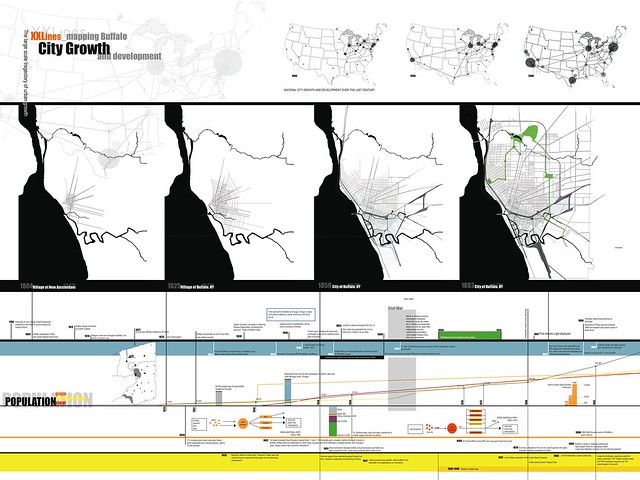Students from the MIT School of Architecture + Planning have been visiting Buffalo, NY this semester. Working with Brent Ryan, whose work focuses on urban revitalization of older cities, students have created the following site - Shrinking City @MIT - Buffalo Studio. The site is dynamic and full of amazing illustrations.
image courtesy of Shrinking City @MIT
From the introduction:
The Spring 2010 Shrinking Cities Buffalo studio is the first of a series of urban design studios that will propose comprehensive spatial strategies for shrinking cities. The studio examines the paradigmatic shrinking city of Buffalo, NY (1950 population 580,000, current population 270,000.) The city is well known as a historic innovator in architectural and urban design, with extensive work from Olmsted, Wright, Sullivan, Richardson, Burnham, and SOM as well as the concrete grain elevators made famous in Corbusier’s Vers Une Architecture of 1924. Buffalo has always been dependent on marine infrastructure: the Erie Canal of 1825 effectively started the city’s growth, and the St. Lawrence Seaway of 1959 categorically ended it.Buffalo today is faced with a myriad of crises. The current housing bust is only the latest in a series of events that seem to have conspired against the city. Among these are long-term economic decline stemming from economic-infrastructural shifts such as the Seaway; the suburbanization of the middle class; the nationwide shift toward the warmer Sunbelt cities; racial polarization and segregation; and globalization. The negative effects of these forces are clear to any visitor. The city’s population has fallen dramatically and housing abandonment is a serious problem in the most distressed areas of the city.Despite these problems, Buffalonians have retained a sense of optimism toward the future. The city has inherited an impressive legacy of institutions from its past, and its design heritage is particularly strong. Buffalo’s amenities are spectacular for its size, and costs of living are low. Residents are friendly, approachable, and eager to discuss new ideas. The city’s industrial character is gritty and appealing, giving it a unique local flavor in an increasingly homogenized, chain-dominated, auto-dependent nation. The city’s political and social leadership is dedicated to making Buffalo livable under difficult circumstances that will not ease up any time soon.What is the role for urban design given this situation? The studio attempts to answer this question.
Thinking about these issues and attracting some of the sharpest young minds to help manage and shape urban policy is critically important. The material generated from the SA+P studio will no doubt become an important part of the dialog here.
Related posts:
- Learning from Youngstown - Part III (1/21/10)
- Learning from Others (11/20/06)
- Why not, Buffalo? 6/24/07
- Emerging Patterns 2/01/07
- Requiem for Detroit
__________________________________________________________________________
building index • fixBuffalo flickr • creative class • shrinking cities • americansuburbX
spacing toronto • infrastructurist • inhabitat
building index • fixBuffalo flickr • creative class • shrinking cities • americansuburbX
spacing toronto • infrastructurist • inhabitat


2 comments:
This is pretty great and it's about time someone included Buffalo in this project - but how is it possible that someone from MIT managed to spell 'STEEL' wrong on the diagram..? They could not possibly have meant 'STEAL'.?
Not to be picky but it does tend to distract (in a Freudian way) from the intent.
This. Is. Awesome.
Actually, 1962, if you look closely there were tons of type-os on that thing. However, I still think it is a beautiful document and I would love to know what they created it with.
Post a Comment